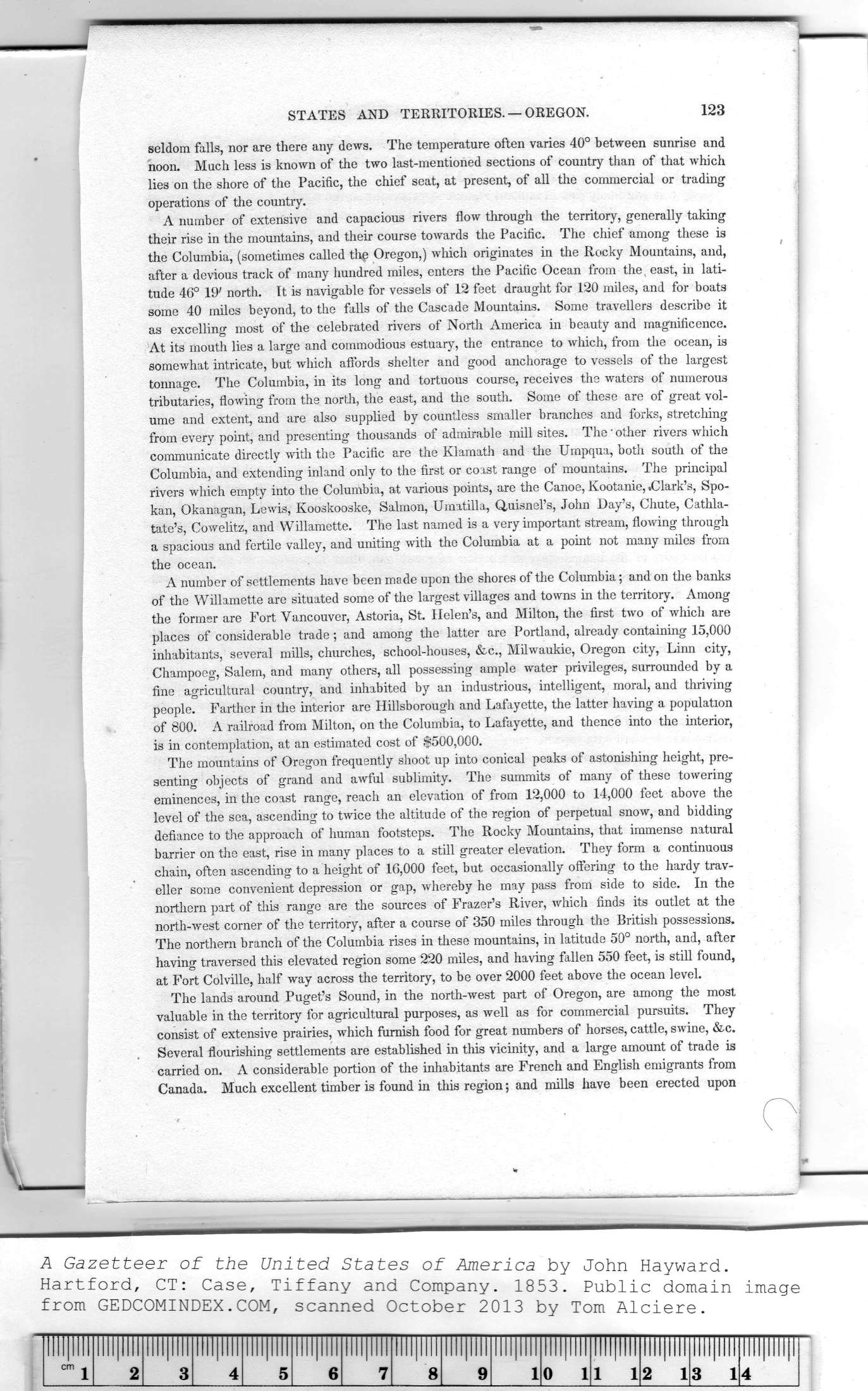|
|
Note: Ctrl and + increases the font size of the text below, Ctrl and - decreases it, and Ctrl and 0 resets it to default size.
STATES AND TERRITORIES. — OREGON. 123
seldom falls, nor are there any dews. The temperature often varies 40° between sunrise and
noon. Much less is known of the two last-mentioned sections of country than of that which
lies on the shore of the Pacific, the chief seat, at present, of all the commercial or trading
operations of the country.
A number of extensive and capacious rivers flow through the territory, generally taking
their rise in the mountains, and their course towards the Pacific. The chief among these is
the Columbia, (sometimes called the Oregon,) which originates in the Rocky Mountains, and,
after a devious track of many hundred miles, enters the Pacific Ocean from the east, in lati-
tude 46° 19' north. It is navigable for vessels of 12 feet draught for 120 miles, and for boats
some 40 miles beyond, to the falls of the Cascade Mountains. Some travellers describe it
as excelling most of the celebrated rivers of North America in beauty and magnificence.
At its mouth lies a large and commodious estuary, the entrance to which, from the ocean, is
somewhat intricate, but which affords shelter and good anchorage to vessels of the largest
tonnage. The Columbia, in its long and tortuous course, receives the waters of numerous
tributaries, flowing from the north, the east, and the south. Some of these are of great vol-
ume and extent, and are also supplied by countless smaller branches and forks, stretching
from every point, and presenting thousands of admirable mill sites. The' other rivers which
communicate directly with the Pacific are the Klamath and the Umpqua, both south of the
Columbia, and extending inland only to the first or coast range of mountains. The principal
rivers which empty into the Columbia, at various points, are the Canoe, Kootanie, .Clark's, Spo-
kan, Okanagan, Lewis, Kooskooske, Salmon, Umatilla, Qnisnel's, John Day's, Chute, Cathla-
tate's, Cowelitz, and Willamette. The last named is a very important stream, flowing through
a spacious and fertile valley, and uniting with the Columbia at a point not many miles from
the ocean.
A number of settlements have been made upon the shores of the Columbia; and on the banks
of the Willamette are situated some of the largest villages and towns in the territory. Among
the former are Fort Vancouver, Astoria, St. Helen's, and Milton, the first two of which are
places of considerable trade ; and among the latter are Portland, already containing 15,000
inhabitants, several mills, churches, school-houses, &c., Milwaukie, Oregon city, Linn city,
Champoeg, Salem, and many others, all possessing ample water privileges, surrounded by a
fine agricultural country, and inhabited by an industrious, intelligent, moral, and thriving
people. Farther in the interior are Hillsborough and Lafayette, the latter having a population
of 800. A railroad from Milton, on the Columbia, to Lafayette, and thence into the interior,
is in contemplation, at an estimated cost of $500,000.
The mountains of Oregon frequently shoot up into conical peaks of astonishing height, pre-
senting objects of grand and awful sublimity. The summits of many of these towering
eminences, in the coast range, reach an elevation of from 12,000 to 14,000 feet above the
level of the sea, ascending to twice the altitude of the region of perpetual snow, and bidding
defiance to the approach of human footsteps. The Rocky Mountains, that immense natural
barrier on the east, rise in many places to a still greater elevation. They form a continuous
chain, often ascending to a height of 16,000 feet, but occasionally offering to the hardy trav-
eller some convenient depression or gap, whereby he may pass from side to side. In the
northern part of this range are the sources of Frazer's River, which finds its outlet at the
north-west corner of the territory, after a course of 350 miles through the British possessions.
The northern branch of the Columbia rises in these mountains, in latitude 50° north, and, after
having traversed this elevated region some 220 miles, and having fallen 550 feet, is still found,
at Fort Colville, half way across the territory, to be over 2000 feet above the ocean level.
The lands around Puget's Sound, in the north-west part of Oregon, are among the most
valuable in the territory for agricultural purposes, as well as for commercial pursuits. They
consist of extensive prairies, which furnish food for great numbers of horses, cattle, swine, &c.
Several flourishing settlements are established in this vicinity, and a large amount of trade is
carried on. A considerable portion of the inhabitants are French and English emigrants from
Canada. Much excellent timber is found in this region; and mills have been erected upon
|
lllllllll |
lllllllll |
lllllllll |
lllllllll |
lllllllll |
lllllllll |
lllllllll |
lllllllll |
lllllllll |
lllllllll |
lllllllll |
lllllllll |
lllllllll |
lllllllll |
llll|llll|l| |
|
Cl11 j |
2 |
3 |
4 |
5 |
6 |
7 |
8 |
9 |
1 |
0 1 |
1 1 |
2 1 |
3 1 |
4 |
|
